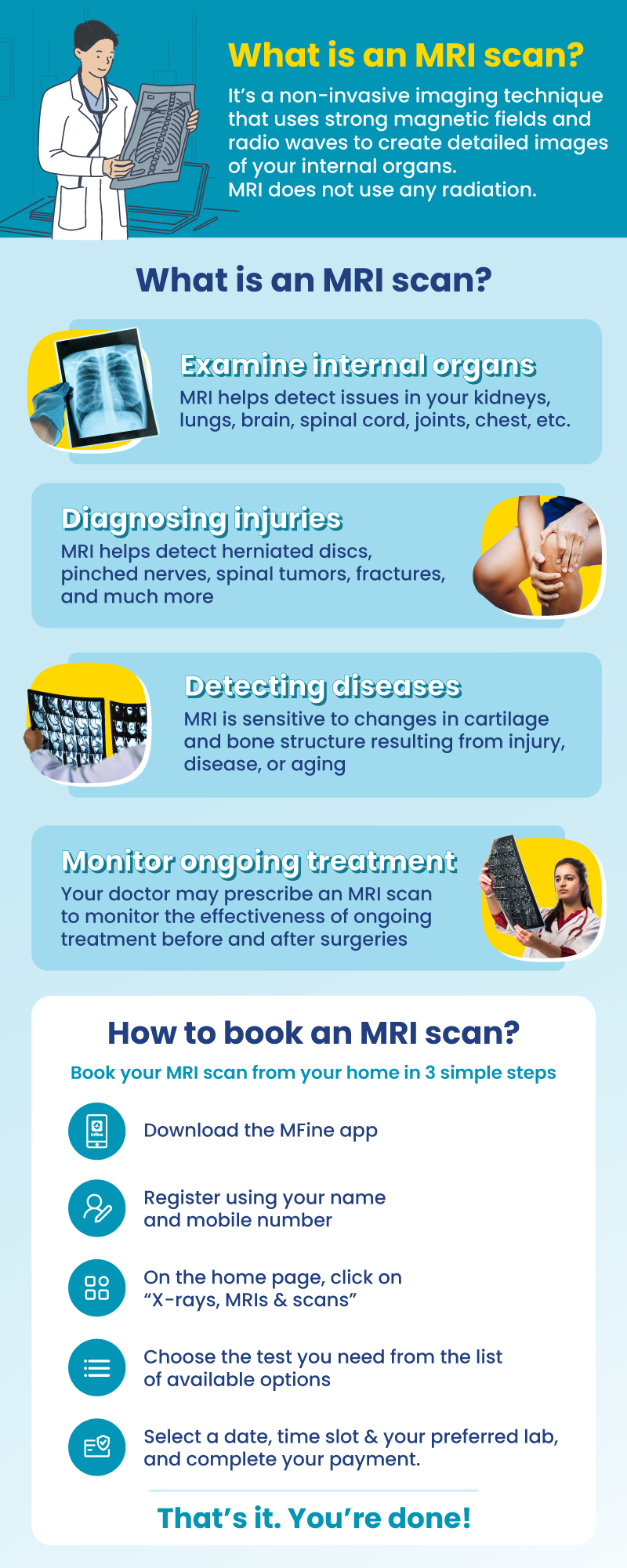
Exciting offer: Get good discounts on Spine MRI scans in Pune without compromising on the quality of lab services.
MFine offers you high-quality lab options, and an excellent discount of upto 50%, for your MRI Spine in Pune.
MRI Scan Spine in Pune by MFine
|
Generally, the market price of an MRI spine scan is above ₹6,500 but with us, you can get it for ₹3500 only.
Avail of this exclusive offer by calling us on
Or you can click on the button below for us to call you back.
You can book an online doctor consultation after booking the test.
Spine MRI scan costs in Pune
Stay updated on the commonly available Spine MRI scans in Pune and their discounted rates mentioned below. Remember, prices may be subject to change, so feel free to contact us for the latest pricing.
| MRI Scan Spine Cost in Pune | Offer Price |
| MRI Whole Spine Price in Pune | ₹10000 |
| MRI Cervical Spine Price in Pune | ₹3500 |
| MRI Dorsal Spine Price in Pune | ₹3500 |
| MRI Lumbar Spine Price in Pune | ₹3500 |
For any inquiries, don’t hesitate to contact us at ☏08061970525.
Why should I book MRI through MFine?
|
Exclusive Benefits with MFine
(1) Certified labs
Get access to over 600+ labs certified by NABL and NABH
(2) Same-day slot available
Get scans done on the same day
(3) Quick and convenient
Get reports in 12 hours and digital films in 15 – 20 minutes
(4) FREE Consultation
Post scans, consult a doctor for free to review your report
MRI of the Spine
The human spine is a remarkable and intricate structure composed of several components that work together to provide support, protection, and mobility to the body. Understanding the key elements of the spine can help appreciate its importance in maintaining overall health and functionality.
(1) Vertebrae:
The spine consists of 33 small bones called vertebrae, arranged in a column-like structure.
These vertebrae can be categorized into five regions: cervical (neck), thoracic (upper back), lumbar (lower back), sacral (pelvic), and coccygeal (tailbone).
The vertebrae form the backbone of the spinal column, giving it strength and stability.
They play a crucial role in supporting the body’s weight and facilitating movement.
(2) Facet Joints:
The facet joints are small synovial joints located between adjacent vertebrae.
These joints enable spinal flexibility and facilitate smooth movements, such as bending, twisting, and turning.
Each facet joint is coated with cartilage, which helps reduce friction during motion.
The design and orientation of these joints vary in different regions of the spine, allowing for specific ranges of motion.
(3) Intervertebral Disks:
Intervertebral disks are flat, round cushions positioned between adjacent vertebrae.
They serve as shock absorbers, cushioning the impact of daily activities and movements on the spine.
Each disk has a central gel-like portion called the nucleus pulposus, surrounded by a tough fibrous ring called the annulus fibrosus.
The structure of intervertebral disks allows for flexibility while maintaining stability.
(4) Spinal Cord and Nerves:
The spinal cord is a vital component of the central nervous system, extending through the spinal canal formed by the vertebrae.
It is a bundle of nerves responsible for transmitting sensory information from the body to the brain and motor signals from the brain to the muscles.
The spinal cord is encased and protected by the bony vertebral column, safeguarding it from external injury.
Nerves branch out from the spinal cord at various levels of the spine, distributing signals to different parts of the body.
(5) Soft Tissues:
Soft tissues surrounding the spine play an essential role in maintaining its alignment and supporting its function.
Ligaments are strong, fibrous connective tissues that attach bone to bone, providing stability to the spine and preventing excessive movement.
Muscles surrounding the spine help control posture, support the body’s weight and facilitate various movements.
Tendons are fibrous cords that connect muscles to bones, enabling coordinated and controlled movements.
What are the different spine segments?
The different segments of the spine include:
(1) Cervical (neck):
- Consists of 7 vertebrae (C1 to C7).
- Enables neck movements, like turning your head or nodding.
- Protects the neural pathways that send signals between the brain and the rest of the body.
(2) Thoracic (middle back):
- Contains 12 thoracic vertebrae (T1 to T12).
- Supports the middle back and chest region.
- Helps protect the vital organs in the chest area.
(3) Lumbar (lower back):
- Comprises 5 vertebrae (L1 to L5).
- Provides stability to the lower back.
- Supports the weight of the upper body and helps with standing, walking, and bending.
(4) Sacrum:
- A triangular bone formed by the fusion of 5 sacral vertebrae.
- Connects the spine to the hip bones, providing support and stability to the pelvis.
(5) Coccyx (tailbone):
- Composed of coccygeal vertebrae.
- Located at the very end of the spine.
- Serves as an attachment point for various muscles and ligaments.
The spine, or vertebral column, is a crucial part of the body’s skeletal system. It not only provides structural support but also protects the delicate spinal cord and nerves that transmit messages between the brain and the rest of the body. Each region of the spine has its specific functions and plays an essential role in maintaining mobility, stability, and overall well-being.

Which disorders can be diagnosed using a spine MRI?
When it comes to diagnosing a wide range of disorders, a spine MRI is an invaluable resource, revealing conditions like:
- Arthritis, with a focus on ankylosing spondylitis affecting spinal joints
- Back strains and sprains resulting from injuries or strain
- Birth defects, specifically spina bifida impacting spinal development
- Bone spurs, abnormal bony growths affecting spinal structures
- Curvatures of the spine, encompassing scoliosis and kyphosis
- Neuromuscular diseases like ALS, affecting nerve and muscle function
- Nerve injuries such as spinal stenosis, sciatica, and pinched nerves
- Osteoporosis, leading to weakened and brittle bones
- Spinal cord injuries involving fractures, herniated disks, and paralysis
- Spine tumors and cancerous growths within the spinal region
- Spine infections like meningitis and osteomyelitis
Why would a doctor prescribe a spine MRI?
For diagnostic purposes, doctors may recommend a spine MRI for the following reasons:
- Diagnosing and evaluating spinal conditions like arthritis, bone spurs, and curvatures (scoliosis, kyphosis).
- Assessing and monitoring back injuries, including strains, sprains, and fractures.
- Investigating nerve-related issues such as spinal stenosis, sciatica, and pinched nerves.
- Detecting and evaluating spinal cord injuries, herniated disks, and spinal tumors.
- Diagnosing infections like meningitis and osteomyelitis that affect the spine.
Prerequisites for a Spine MRI
Before undergoing a spine MRI, specific prerequisites must be met, including:
- Medical referral: Patients typically need a doctor’s prescription or referral to arrange a spine MRI.
- Pre-scan questionnaire: Patients may be required to complete a questionnaire to ensure MRI safety and appropriateness.
- Medical history disclosure: Informing the healthcare provider about any medical conditions, allergies, or prior surgeries is essential.
- Metal object removal: To avoid MRI interference, patients should remove metal items such as jewelry, watches, piercings, and hearing aids.
- Pregnancy status: Female patients must inform the healthcare provider if they are pregnant or suspect pregnancy, as MRI scans are generally avoided during pregnancy, especially in the first trimester.
FAQs
How much does a spine MRI cost in Pune?
The market price for a spine MRI is usually above ₹6,500. However, when you book with MFine, you’ll get this only for ₹3,500.
Which MRI for the lumbar spine?
For evaluating the lumbar spine, a lumbar spine MRI is the most appropriate imaging technique. It focuses specifically on the lower back region and provides detailed images of the lumbar vertebrae, discs, nerves, and surrounding structures.
Is an MRI covered by insurance?
In many cases, MRI scans are covered by health insurance, but the coverage can vary depending on the insurance plan and the reason for the MRI. Insurance policies may have specific criteria or require pre-authorization for the MRI to be covered. Patients are advised to check with their insurance provider to understand the coverage details and any potential out-of-pocket expenses.
How long will a spine MRI take?
The duration of a spine MRI can vary depending on the specific area being imaged and the complexity of the scan. On average, a spine MRI may take around 30 to 60 minutes to complete. However, this time can be longer if additional sequences or contrast-enhanced imaging is required.
Which MRI is best for lower back pain?
For lower back pain, a lumbar spine MRI is generally the most suitable imaging technique. It allows for a detailed assessment of the lumbar vertebrae, discs, nerves, and other structures in the lower back region, helping to diagnose the underlying cause of the pain.
What does an MRI of the cervical spine show?
An MRI of the cervical spine shows detailed images of the neck region, including the cervical vertebrae, spinal cord, nerve roots, discs, and surrounding soft tissues. It helps in identifying conditions such as herniated discs, spinal stenosis, tumors, infections, or any other abnormalities affecting the neck area.
Is a cervical MRI painful?
No, a cervical MRI is generally not painful. The procedure is non-invasive and painless. However, some people may experience discomfort or claustrophobia due to the enclosed space inside the MRI machine. If you have concerns about claustrophobia, you can discuss them with the healthcare provider beforehand.
When is a cervical MRI needed?
A cervical MRI is typically needed when there are symptoms or indications of issues in the neck region. It is ordered by healthcare providers to evaluate conditions such as neck pain, numbness or tingling in the arms or hands, weakness, suspected herniated discs, spinal cord compression, or other cervical spine-related problems.
Read about MRI scan side effects.
What do I wear for a cervical MRI?
You will be asked to wear loose, comfortable clothing without any metal components for a cervical MRI. It is essential to remove any jewelry, watches, or accessories that contain metal, as they can interfere with the MRI imaging process.
Can you eat before a cervical MRI?
Yes, you can generally eat before a cervical MRI. Unlike some other medical imaging procedures, MRI does not require fasting. However, you may be advised to avoid heavy meals or certain foods that could cause discomfort during the scan. It is essential to follow any specific instructions provided by the healthcare facility where you will undergo the MRI.
Other topics you may be interested in
| For further assistance call us on ☏08061970525 |

 Call us:
Call us:


 Call
Now
Call
Now